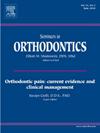Breaking the glass ceiling: Women representation in orthodontic societies' leadership and awards
IF 2
4区 医学
Q2 DENTISTRY, ORAL SURGERY & MEDICINE
引用次数: 0
Abstract
This cross-sectional study evaluated women's representation in orthodontic societies, focusing on leadership roles, award recipients, and award namesakes. Orthodontic societies affiliated with the World Federation of Orthodontists (WFO) that had accessible websites with sufficient information about board members were included. Gender distribution of board members, award recipients, and award namesakes for orthodontic societies was extracted in a pre-piloted sheet. Societies were grouped by region, and the percentage of female board members per region was calculated. Board member roles and gender distribution for each role were summarized. The percentage of current female orthodontic society presidents was calculated. Additionally, the number of female award recipients and award namesakes were extracted and summarized as percentages. A total of 119 orthodontic societies were identified, of which 67 were included in the analysis. Central and South America had the highest board representation of women (53.7 %) and female presidents (60 %), while North America had the lowest board representation (22.2 %) and no female presidents (0 %). Women predominantly occupied administrative and secretarial support roles in orthodontic societies (47.2 %), and were underrepresented in leadership roles. The European Federation of Orthodontics (FEO) had the highest percentage (80 %) of female award recipients, while the American Board of Orthodontics (ABO) had the lowest (15 %). Overall, female representation among award recipients and namesakes remains limited. Efforts should be made by orthodontic societies to address these issues by implementing targeted initiatives to increase female recognition and representation in leadership roles.
打破玻璃天花板:女性在正畸协会的领导和奖励中的代表性
这项横断面研究评估了女性在正畸社会中的代表性,重点关注领导角色、获奖者和获奖者。隶属于世界正畸医师联合会(WFO)的正畸学会也包括在内,这些学会拥有可访问的网站,并提供有关理事会成员的充分信息。正畸学会董事会成员、获奖者和与奖项同名的人的性别分布被提取在一份预先试点的表格中。协会按地区分组,并计算每个地区女性董事会成员的百分比。总结了董事会成员的角色和每个角色的性别分布情况。计算了现任女性正畸学会会长的百分比。此外,还提取了女性获奖者和同名获奖者的数量,并将其汇总为百分比。共有119个正畸学会被确定,其中67个被纳入分析。中南美洲的女性董事比例最高(53.7%),女性总裁比例最高(60%),而北美的女性董事比例最低(22.2%),没有女性总裁(0%)。在正畸协会中,妇女主要担任行政和秘书支持角色(47.2%),在领导角色中代表性不足。欧洲正畸联合会(FEO)的女性获奖者比例最高(80%),而美国正畸委员会(ABO)的女性获奖者比例最低(15%)。总体而言,获奖者和同名获奖者中女性的比例仍然有限。正畸协会应该努力通过实施有针对性的举措来解决这些问题,以提高女性在领导角色中的认可度和代表性。
本文章由计算机程序翻译,如有差异,请以英文原文为准。
求助全文
约1分钟内获得全文
求助全文
来源期刊

Seminars in Orthodontics
DENTISTRY, ORAL SURGERY & MEDICINE-
CiteScore
2.20
自引率
4.80%
发文量
28
审稿时长
10 days
期刊介绍:
Each issue provides up-to-date, state-of-the-art information on a single topic in orthodontics. Readers are kept abreast of the latest innovations, research findings, clinical applications and clinical methods. Collection of the issues will provide invaluable reference material for present and future review.
 求助内容:
求助内容: 应助结果提醒方式:
应助结果提醒方式:


